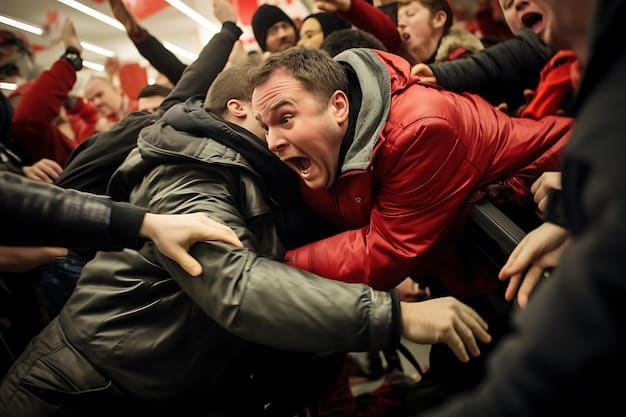MLS Player Unions: Goals, Impact, and League Influence in US Soccer

MLS player unions, primarily the Major League Soccer Players Association (MLSPA), aim to protect player rights, negotiate better working conditions and compensation, and influence league policies to ensure fair treatment and overall growth of soccer in the United States.
The landscape of Major League Soccer (MLS) is shaped not only by the players on the field but also by the forces working behind the scenes. Among these are the player unions, with the Major League Soccer Players Association (MLSPA) being the most prominent. Understanding the MLS Player Unions: What Are Their Key Objectives and How Do They Influence League Policy? is essential to understanding the sport’s present and future in the United States.
Key Objectives of MLS Player Unions
MLS player unions, like any labor organization, exist to represent the collective interests of their members. Their primary goals are centered around enhancing the working conditions, pay, and overall welfare of the players. Understanding these objectives provides insight into the dynamics between the players and the league management.
Negotiating Collective Bargaining Agreements (CBAs)
At the heart of any player union’s mission is the negotiation of a Collective Bargaining Agreement (CBA). This legally binding contract outlines the terms and conditions of employment for all players in the league.
Securing Fair Wages and Benefits
One of the most critical aspects of the CBA is securing fair wages and benefits for the players. This includes not only base salaries but also bonuses, health insurance, retirement plans, and other benefits.
- Ensuring competitive salaries reflective of player talent and market value.
- Providing comprehensive health insurance coverage for players and their families.
- Establishing robust retirement plans to secure players’ financial futures.
- Negotiating for additional benefits such as housing allowances and travel accommodations.

Protecting Player Rights and Safety
Beyond compensation, player unions are deeply involved in protecting the rights and safety of their members. This includes advocating for safe playing conditions, injury prevention protocols, and mechanisms for addressing player grievances.
MLS Player Unions advocate to provide:
- Implementing stringent concussion protocols and ensuring access to top-notch medical care.
- Addressing issues of harassment, discrimination, and other forms of misconduct.
- Establishing clear procedures for resolving disputes between players and the league.
In conclusion, MLS player unions have a main focus on bettering terms between the players and the League. By prioritizing fair compensation, benefits, and player protections these unions try to establish equity and support the growth of professional soccer in the US.
The Influence of MLS Player Unions on League Policy
The influence of MLS player unions extends beyond the negotiation of CBAs. These organizations also play a significant role in shaping league policy, advocating for changes that benefit players and contribute to the overall growth and competitiveness of the sport. This influence can be seen in various aspects of the league’s operations.
Impacting Roster Rules and Regulations
MLS roster rules and regulations can significantly impact a player’s career and earning potential. Player unions actively engage in discussions with the league to influence these rules, aiming to create a fairer and more equitable system.
Advocating for Player Development Initiatives
Recognizing the importance of player development, MLS player unions often advocate for initiatives that promote the growth of soccer at the grassroots level.
- Supporting youth academies and development programs to cultivate young talent.
- Investing in coaching education and resources to improve the quality of training.
- Promoting community outreach programs to increase participation in soccer.
Promoting Competitive Balance
While advocating for their members’ interests, MLS player unions also recognize the importance of competitive balance within the league. A more balanced league is good for the fans, good for the sport, and ultimately, good for the players.
- Supporting mechanisms such as salary caps and allocation money to prevent disparities in team spending.
- Advocating for policies that encourage the development of talent across all teams.
- Working with the league to ensure fair distribution of resources and opportunities.
In essence, MLS player unions have a substantial influence on league policy. They champion player development from the ground up and promote competitive equilibrium, ensuring a just and dynamic scene for professional soccer.
Historical Overview of MLS Player Unions
To fully appreciate the current role and influence of MLS player unions, it’s essential to understand their historical evolution. The journey of these organizations has been marked by challenges, milestones, and a relentless pursuit of player rights.
Early Struggles and Formation
The early years of MLS were characterized by financial instability and limited player protections. In this environment, a small group of players took the initiative to form a union, driven by a desire to improve their working conditions and secure their rights.
Key Milestones and Achievements
Over the years, MLS player unions have achieved several key milestones that have significantly improved the lives of players and shaped the landscape of the league. These achievements include:
- Successfully negotiating the first CBA, establishing baseline standards for player compensation and benefits.
- Advocating for free agency rights, allowing players more control over their careers.
- Securing improved health insurance and retirement benefits for players and their families.
Challenges and Setbacks
Despite their successes, MLS player unions have also faced challenges and setbacks along the way. These challenges include:
- Navigating complex labor laws and regulations.
- Overcoming resistance from league owners and management.
- Maintaining member solidarity in the face of competing interests.
MLS player unions were formed after early difficulties and proceeded to achieve great milestones that improved compensation and benefit conditions. Despite the existence of obstacles, these unions exhibit a strong desire to defend the rights of players.
The Role of the MLSPA in Shaping Player Compensation
One of the most visible and impactful roles of the Major League Soccer Players Association (MLSPA) is its influence over player compensation. Through collective bargaining and advocacy, the MLSPA has significantly shaped the financial landscape for MLS players.
Negotiating Salary Caps and Minimum Salaries
The MLSPA plays a crucial role in negotiating salary caps and minimum salaries for MLS players. These mechanisms are designed to promote competitive balance while ensuring that all players receive fair compensation.

Advocating for Allocation Money and Designated Player Rules
In addition to salary caps and minimum salaries, the MLSPA also advocates for the use of allocation money and the Designated Player Rule. These mechanisms allow teams to invest in higher-priced talent while remaining compliant with league regulations.
Addressing Wage Inequality and Discrimination
Wage inequality and discrimination are persistent issues in professional sports, including MLS. The MLSPA actively works to address these issues, advocating for equal pay and opportunities for all players, regardless of race, gender, or other protected characteristics.
The MLSPA has a big impact on player compensation at all levels; working on basic compensation to promote equality. Its role is essential for ensuring that MLS players are sufficiently compensated and fairly treated. This leads to competitive sports and a healthy working environment.
Comparing MLS Player Unions to Other Sports Leagues
To gain a broader perspective on the role and influence of MLS player unions, it’s helpful to compare them to their counterparts in other major sports leagues. While all player unions share similar goals, there are notable differences in their approaches and levels of influence.
Similarities and Differences in Collective Bargaining
One of the key areas of comparison is the process of collective bargaining. Like other player unions, the MLSPA negotiates with league management to establish the terms and conditions of employment for its members.
Several comparisons are noticed in the collective bargaining process:
- Some unions, such as the NFLPA and MLBPA, have a longer history and more established bargaining relationships.
- Other unions, such as the NBA Players Association, have a reputation for being more confrontational and aggressive in their negotiations.
Variations in Player Rights and Benefits
Another area of comparison is the extent of player rights and benefits. While all player unions strive to protect their members’ interests, there are variations in the specific rights and benefits they have secured.
There are some variations to player rights and benefits:
- Some unions have successfully negotiated for greater free agency rights, allowing players more control over their movement between teams.
- Other unions have secured more comprehensive health insurance and retirement benefits for their members.
Levels of Influence on League Policy
Finally, it’s important to compare the levels of influence that player unions wield over league policy. Some unions have a greater say in shaping the rules and regulations of their respective leagues than others.
MLS is different to other leagues and there are variations of how league policies are influenced:
- Some unions have a formal seat at the table when it comes to making decisions about league operations.
- Other unions rely more on informal channels of communication and persuasion to influence league policy.
Therefore, MLS Player Unions are different from other sports leagues depending on history, power and how they defend their rights. It faces unique problems when promoting competitive pay, player benefits and fair treatment, which is important for its continued growth.
Future Trends and Challenges for MLS Player Unions
Looking ahead, MLS player unions will face a range of evolving trends and challenges that will shape their role and influence in the years to come. These trends and challenges include:
The Growing Importance of Data Analytics
Data analytics is playing an increasingly important role in professional sports, including MLS. Player unions will need to adapt to this trend by developing strategies for using data to their advantage in negotiations and advocacy.
- Harnessing data to demonstrate player value and justify higher salaries.
- Using data to identify and address issues of player safety and well-being.
The Rise of Global Soccer
The rise of global soccer is also having a significant impact on MLS. Player unions will need to navigate issues such as international player transfers, salary disparities, and the integration of diverse cultural and linguistic backgrounds.
- Working with the league to establish fair and transparent transfer policies.
- Advocating for equal pay and opportunities for all players, regardless of nationality or background.
The Pursuit of Social Justice
Finally, MLS player unions are likely to become more involved in the pursuit of social justice. This may involve taking public stances on issues such as racial equality, LGBTQ+ rights, and climate change.
- Partnering with community organizations to promote social change.
- Using their platform to raise awareness about important social issues.
MLS player unions can foresee future challenges and changes depending on data analytics, the rise of global soccer as well as the search for social justice. Their flexibility is necessary for them to keep defending player interests and supporting the growth of soccer in America.
| Key Topic | Brief Description |
|---|---|
| 🤝 CBA Negotiations | Unions negotiate fair employment terms for all players. |
| 🛡️ Player Rights | Unions strive to protect players rights and safety. |
| ⚽ Development Initiatives | Advocating for programs that support youth soccer growth. |
| ⚖️ Competitive Balance | Promoting equitable resource distribution among MLS teams. |
Frequently Asked Questions
▼
The primary goal is to represent players interests in terms of negotiating better working conditions, fair wages and protection and generally advocate for their welfare across the board.
▼
The Major League Soccer Players Association (MLSPA) represents all current players in Major League Soccer and it works to ensure their rights and benefits are protected across the League.
▼
Player compensation and benefits are negotiated for example things like minimum salaries, health insurance, and retirement plans to guarantee players have the money to earn a livelihood and safety.
▼
By engaging them in serious discussions and talking about player development, promotion of competition balance also looking at matters like equal pay and non discrimination in MLS.
▼
They need to address ever growing changes, like the importance of data analytics, globalization of football, social justice issues and keeping their members rights and benefits protected.
Conclusion
MLS player unions play a vital role in shaping the landscape of professional soccer in the United States. From negotiating fair wages and benefits to advocating for player safety and influencing league policy, these organizations are essential for ensuring that players’ voices are heard and their rights are protected. As MLS continues to grow and evolve, player unions will undoubtedly remain a critical force in shaping the future of the sport.





